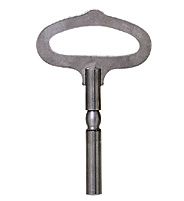-
Clock parts
-
After brand and calibre
-
Press-fit bearings
-
Pulley wheels
-
Cabinet fittings/accessories
-
Body trim
-
Weights/accessories
-
Glass bells
-
Bells/accessories
-
Chime rods/Gong springs
- Clock key
-
Hammers/accessories
-
Chains/ropes/strings/accessories
-
Cuckoo pipes/Accessories
-
Pendulum/accessories
-
Suspension springs
-
Raw shoots
-
Screws/nuts
-
Swiss anchor escapements
-
Pawl springs
-
Sperraeder
-
Drivers
-
Watch stand
-
Clock wallpaper
-
Balance shaft after U no.
-
Washers
-
Cotter pins
-
Hand/accessories
-
Central screw
-
Dials/accessories
-
Other Accessories
-
After brand and calibre


Winding keys 5,50mm
Product number:
334739
Packaging Unit:
1
From Stock
| Application: | 5,50 |
|---|---|
| Article name: | Large clock key |
| Interior dimension Ø mm: | 5,50 |
| Manufacturer name: | 13 |
| Material: | steel |
| Processing mode: | verchromt |
| Special feature: | long shaft |
Manufacturer Informations
Name: Rudolf Flume Technik GmbH
Street: Hachestr. 66
City: 45127 Essen
Country: DE
Email: info@flume.de
Phone: 0049-201-18990
0 of 0 reviews
Login
No reviews found. Be the first to share your insights.
Product information "Winding keys 5,50mm"
For mantel, wall and longcase clocks.
Clock Key Square Sizes
The traditional key sizes Nos. 00 to 15 are known to clockmakers only.
The dimensions that are used to define a clock key refer to the size of the square of the movements winding arbor. This square needs to be measured (with calipers!), the result is rounded off to the next 0.25 mm, and then a matching key is selected. A key will be supplied with the correct plus-tolerance (basic size plus c. 0.1 mm).
In older clocks with tapered winding arbors, do not measure the small end but closer to the largest end of the taper. The result is then rounded off to the next 0.25 mm and a matching key selected.
If the cross section of a winding arbor is not exactly square, but more rectangular, use the dimension of the wider side.
Damaged winding arbors oftentimes are re-worked during repairs. This - and the replacement of the mainspring with a stronger model - can cause undue stress upon the winding key, causing damage or even destruction to its sleeve. Damage can also be caused if the edges of the movement's winding square are worn or rounded off. In such cases, a warranty - limited to the replacement of the winding key - is excluded.
Please note: When measuring a winding key's square, do not measure the diameter of the hole, but to parallel corners. The cross section of the hole is not exactly square since it is based on a round hole, which is then broached to achieve a square. Since the diameter of the hole is slightly larger than the actual key size, measuring the diameter of hole will result in an incorrect dimension - the key will be too wide.
Clock Key Square Sizes
The traditional key sizes Nos. 00 to 15 are known to clockmakers only.
The dimensions that are used to define a clock key refer to the size of the square of the movements winding arbor. This square needs to be measured (with calipers!), the result is rounded off to the next 0.25 mm, and then a matching key is selected. A key will be supplied with the correct plus-tolerance (basic size plus c. 0.1 mm).
In older clocks with tapered winding arbors, do not measure the small end but closer to the largest end of the taper. The result is then rounded off to the next 0.25 mm and a matching key selected.
If the cross section of a winding arbor is not exactly square, but more rectangular, use the dimension of the wider side.
Damaged winding arbors oftentimes are re-worked during repairs. This - and the replacement of the mainspring with a stronger model - can cause undue stress upon the winding key, causing damage or even destruction to its sleeve. Damage can also be caused if the edges of the movement's winding square are worn or rounded off. In such cases, a warranty - limited to the replacement of the winding key - is excluded.
Please note: When measuring a winding key's square, do not measure the diameter of the hole, but to parallel corners. The cross section of the hole is not exactly square since it is based on a round hole, which is then broached to achieve a square. Since the diameter of the hole is slightly larger than the actual key size, measuring the diameter of hole will result in an incorrect dimension - the key will be too wide.
